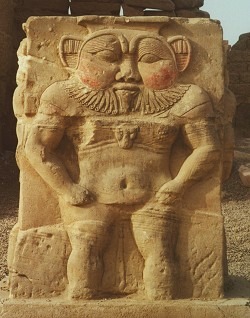
Popular household god, recognisable from his grotesque appearance: the body of a dwarf, crooked legs, the mane and ears of a lion, his tongue often sticking out of his mouth. He wears a head-dress with upstanding feathers and there is usually a tail visible between his legs originally belonging to an animal skin the god is wearing. The god was regarded as a protector against all kinds of danger. This was helped not only by his awful appearance, but also by the attributes he carried in his hands, knives or snakes ('in the hands' meant 'overcome'), a large sa-hieroglyph (= 'protection'), or a musical instrument, usually a drum or tambourine - music not only banished evil spirits but also gave humans a happier, thus less frightened, mood. Representations also show the god dominating a gazelle or a pig, both animals associated with the evil god Seth. Bes was often depicted on objects and places where danger was feared. Furniture used for sleeping, such as a bed or headrest, often bear a representation of Bes or his companion Taweret. When asleep, being unaware of what was happening around them, people were exposed to all the dangers of the night. The dangers involved in the birth of a child could also be prevented by Bes. To this end he is depicted on the so-called magical knives from the Middle Kingdom and, for example, in the birth houses (mammisi) in temples, including Dendera. As a general protection against evil in the Late Period, depictions of Bes or of his head were worn as an amulet around the neck. Bes's role on magical stelae is very interesting. These depict the youthful Horus, himself the conqueror of dangerous animals such as snakes and crocodiles. In almost every instance, the face of Bes is depicted above Horus. Texts make it clear that Bes here is regarded as the old sun god, who is rejuvenated in the solar child. As far as is known, Bes had no cult area of his own. He is, however, present as a 'subsidiary god' in the temples of other gods, where he was sometimes consulted as an oracle. In one of the subsidiary chambers in the temple of Sethos I at Abydos many visitors' inscriptions are dedicated to Bes. In fact, Bes was the personification of a whole group of gods, whose characteristics are so muddled together that it is difficult now to differentiate them. In addition, although depictions of these gods have often been found, textual material is rare; further, only after the New Kingdom is the tradition more informative. At any rate, Bes is closely related to a god with a similar appearance, called Aha ('warrior'). A female counterpart, called Beset, is also known; besides a few depictions dating from the Middle Kingdom, she mainly appears in Ptolemaic sources. In function and appearance she is extremely similar to Bes; she is usually depicted nude.